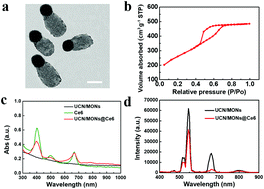A Janus upconverting nanoplatform with biodegradability for glutathione depletion, near-infrared light induced photodynamic therapy and accelerated excretion†
Abstract
The major limitations of photodynamic therapy (PDT) are the poor tissue penetration of excitation light and the neutralization of reactive oxygen species (ROS) generated by overexpressed glutathione (GSH) in cancer cells. Despite tremendous efforts to design nanoplatforms, PDT still suffers from unsatisfactory effects. Furthermore, the residual of nanomaterials in the body has restricted their clinical application. To address these issues, Janus nanocomposites containing an Yb/Er codoped NaYF4 upconverting nanocrystal head and a disulfide-bridged mesoporous organosilicon body (UCN/MON) with loaded chlorin e6 (Ce6) were designed. On one hand, the upconverting nanocrystal head can convert near-infrared (NIR) light into visible light to activate Ce6 to release ROS. On the other hand, the silica body can be degraded though a redox reaction with GSH, to not only improve the tumor selectivity of the photosensitizer by redox- and pH-triggered Ce6 release, but also diminish the concentration of GSH in cancer cells to reduce the depletion of ROS. Thereby, an enhanced PDT triggered by NIR irradiation was achieved. Furthermore, UCN/MONs showed a higher clearance rate after therapeutic actions than nonbiodegradable UCN/MSNs due to their biocompatibility. Taken together, this work revealed the potential of UCN/MONs for highly efficient and NIR-induced PDT, highlighting the prospects of UCN/MONs in the clinic.



 Please wait while we load your content...
Please wait while we load your content...